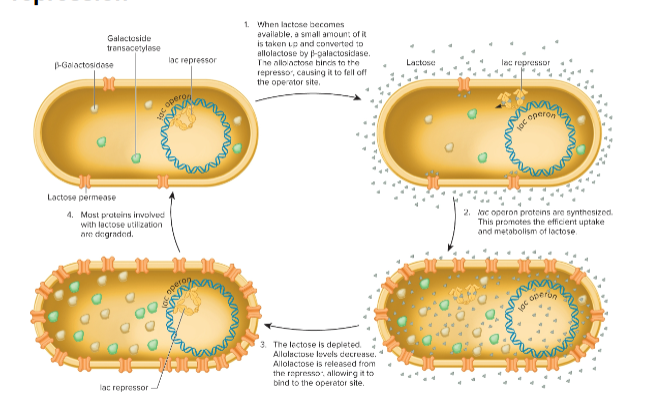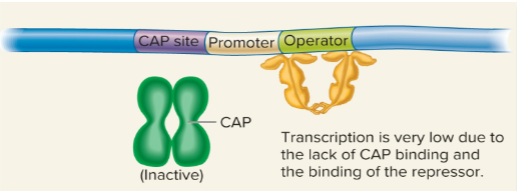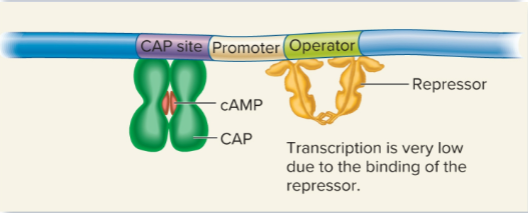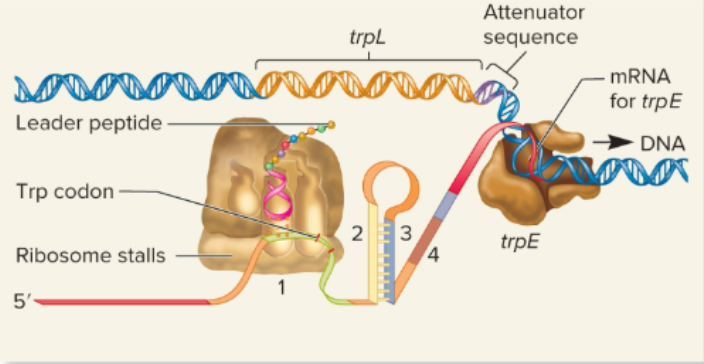Ch. 14: Gene Regulation in Bacteria
1/62
There's no tags or description
Looks like no tags are added yet.
Name | Mastery | Learn | Test | Matching | Spaced |
|---|
No study sessions yet.
63 Terms
What does gene regulation mean?
The level of gene expression can vary under different conditions. This allows coded proteins to be produced only when required. Can occur anywhere in the pathway.
What does constitutive genes mean?
Unregulated genes that have constant levels of expression. Frequently, they code proteins that are continuously necessary for the survival of the organism.
What is the lac operon regulated by?
lac repressor + CAP
What is the trp operon regulated by?
trp repressor + attenuation
Give an example of regulation of gene expression during transcription.
Genetic regulatory proteins bind to the DNA and control the rate of transcription.
Give an example of regulation of gene expression during translation.
Translational repressor proteins can bind to the mRNA and prevent translation from starting.
Antisense RNA can bind to the mRNA and prevent translation from starting.
Give an example of regulation of gene expression during posttranslation.
In feedback inhibition, the product of a metabolic pathway inhibits that first enzyme in the pathway.
Covalent modifications to the structure of a protein can alter its function.
What is the most common way to regulate gene expression in bacteria?
Influencing the initiation of transcription (this allows the rate of RNA synthesis to increase/decrease)
What proteins are required for transcriptional regulation?
regulatory transcription factors (RTFs)
What are the two types of RTFs?
Repressors —> bind to DNA and inhibit transcription
Activators —> bind to DNA and increase transcription
What is negative control?
regulation by repressor proteins
What is positive control?
regulation by activator proteins
What are small effector molecules and what do they do?
They are molecules that bind to RTFs (NOT to DNA)
There are two types of small effector molcules.
inducers: (may INCREASE transcirption) they can bind to activators and cause them to bind to DNA, or, bind to repressors and prevent them from binding to DNA. The genes that are regulated in this manner are termed inducible.
corepressors: (may INHIBIT transcription) through binding to repressors, causes them to bind to DNA
inhibitors: (may INHIBIT transcription) through binding to activators, preventing them from binding to DNA. The genes regulated this way are called repressible.
Which picture shows an example of an inducer small effector molecule acting on a repressor protein?

Which picture shows an example of an inducer small effector molecule acting on a activator protein?

Which picture shows an example of an corepressor small effector molecule acting on a repressor protein?

Which picture shows an example of an inhibitor small effector molecule acting on an activator protein?

What is enzyme adaptation?
a particular enzyme appears in the cell only after the cell has been exposed to the enzymes substrate
What operon/bacteria did François Jacob and Jacques Monod at the Pasteur Institute in Paris focus on regarding enzyme adaptation?
the regulation of lactose operon in E. coil
What is an operon?
a regulatory unit consisting of a few protein-coding genes under the control of one promoter
How does an operon function?
it codes a polycistronic mRNA that contains the coding dequence for 2+ protein-coding genes
This allows a bacterium to coordinately regulate a group of genes that code proteins with a common functional goal.
Is the lacl gene part of the lac operon?
No
What are the DNA elements that control transcription?
promoter → binds to RNA polymerase
operator -→ binds the lac repressor protein
CAP site → binds the catabolite activator protein (CAP)
terminator -→ ends transcription
What are the protein-encoding genes of the lac operon?
lacZ, lacY, lacA
What does the protein-encoding gene lacZ do?
it codes beta-galactosidase, it enzymatically cleaves lactose and lactose analogs, also converts lactose to allolactose
What does protein-encoding gene lacY do?
codes lactose permease, a membrane protein required for transport of lactose and analogs
What does the protein-encoding gene lacA do?
codes galactoside transacetylase, which prevents toxic buildup of nonmetabolizable lactose analogs.
In what ways can the lac operon be transcriptionally regulated?
1) by a repressor protein (negative control)
2) by an activator protein (postiive control)
What is involved through negative control through a repressor protein?
lac repressor, inducer of allolactose (allolactose binds to lac repressor and prevents the repressor from binding to the DNA
What is involved through positive control through a activator protein?
Catabolite Activator Protein (CAP), inducer of cyclic AMP (cAMP) (cAMP is produced from ATP via the enzyme adenylyl cyclase)
How does the lac operon work when there is no lactose in the environment?
In the absence of lactose (no allolactose), the repressor protein is tightly bound to the operator site, thereby inhibiting the ability of RNA polymerase to transcibe the operon.
How does the lac operon work when there is lactose in the environment?
When lactose is avaiable, allolactose is produced. It binds to the repressor. This alters the conformation of the repressor protein, which prevents it from binding to the operator site. Therefore, RNA polymerase can transcribe the operon.
The cycle of lac operon induction and repression through negative control
When lactose becomes available, a small amount of it is taken up and converted into allolactose by beta-galactosidase. The allolactose binds to the repressor, causing it to fall off the operator site.
lac operon proteins are synthesized. This promotes the effcient uptake and metabolism of lactose.
The lactose is depleted. Allolactose levels decrease.. Allolcatose is released from the repressor, allowing it to bind to the operator site.
Most proteins involed with lactose utilization are degraded.

The process of the catabolite repression of the lac operon.
When exposed to both lactose and glucose…
E. coil uses glucose 1st. Catabolite Repression prevents the use of lactose.
After glucose has been used, the catabolite repression is alleviated and the lac operon can be expressed (since the CAP + cAMP complex binds to the CAP site.)
How does the transcription work in the presence of glucose regarding catabolite repression?
the enzyme adenyly cyclase in inhibited, which…
decreases cAMP so it can no longer bind to CAP. Thus, the transcription rate decreases
How does the transcription work in the presence of NO glucose regarding catabolite repression?
cAMP (cyclic AMP) is produced from ATP via the enzyme adenylyl cyclase in the absence of glucose.
cAMP binds to CAP, creating a cAMP-CAP complex.
the cAMP-CAP complex binds to CAP site (a location near the lac promoter), enhancing the binding of RNA polymerase to the promoter. This increases the rate of transcription and is an example of inducible, positive control.
Which picture shows how the lac operon works in the presence of glucose but without lactose?

Which picture shows how the lac operon works in the presence of lactose but without glucose?

What is the trp operon involved in?
The biosynthesis of the amino acid tryptophan.
What genes code for enzymes involved in the tryptophan biosynthesis?
trpE, trpD, trpC, trpB, trp A
What genes are involved in the regulation of the trp operon?
trpR and trpL
What does the trpR gene code for?
it codes for the trp repressor protein (functions in repression)
What does the trpL gene code for?
it codes a short peptide called the leader peptide (functions in attenuation)
What does attenuation mean?
it is a regulatory mechanism for some bacterial operons that results in the premature termination of transcription
How does the trp operon opporate at low tryptophan levels?
the entire trp operon is transcribed, the trp repressor is inactive, there is no tryptophan binding, and RNA polymerase can transcribe the operon (leading to an increase in tryptophan biosynthesis.)
How does the trp operon opporate at high tryptophan levels.
tryptopahn acts as a corepressor that binds to the trp repressor. This creates a tryptophan-trp repressor complex that binds to the operator site to inhibit transcription, since the binding of 2 tryptophan colecules causes a conformational change to the trp repressor.
When happens during attenuation? When can attenuation occur?
When attenuation occurs, the RNA is transcibed only to the attenuator sequence, and then transcipriton is terminated (before trpE/D/C/B/A). No production of tryptophan.
Attenuation can occur in bacteria because transcription and transclation are coupled.
Attenuations occurs during high tryptophan levels.
So, transcription begins at the promoter, through the operator and trpL, but stops at the attenuator sequence.
What segment of the trp operon plays a critical role in attenuation?
the segement immediately downstream fro the operator site.
1st gene of trp operon = trpL (codes the leader peptide)
2 tryptophan codons found within mRNA from the trpL gene (enables the bacterium to sense tryptophan levels)
mRNA from trpL can form stem loops.
When does attenuation NOT ocuur? Why?
low tryptophan levels, 2-3 stem-loop forms.
The ribosome pauses at trp codons in trpL gene due to insufficient amoutns of chargered tRNAtrp. (bc low tryptophan amounts) This pause blocks region 1 of the mRNA, so region 2 can only H-bind with region 3. Thus, the 3-4 stem-loop structure can’t form and transcriptional termination does NOT occur, instead, RNA polymerase transcribed the rest of the operon.

When does attenuation occur? Why?
high tryptophan levels, 3-4 stem-loop forms
During the translation of the trpL gene, once the stop codon is reach, the ribosome pauses. This blocks region 2 from H-bonding with any region and allows region 3 to H-bond with region 4. This terminates transcription at the U-rish attenuator.

Operons that are involved in catabolism are involved in what form of regulation?
Inducible regulation
The substance to be broken down (or a related compoudn) acts as the inducer.
What does catabolism refer to?
the breakdown fo a substance
What does anabolism refer to?
the biosynthesis of a substance
Operons that are involved in anabolism are involved in what form of regulation? Why?
repressible regulation
The inhibitor or corepressor is the small molecule that is the product of the operon.
What are examples of regulation that occurs at later stages in gene expression?
Translational
Translational Repressor
Antisense RNA
Posttranslational
Feedback inhibition
Covalent modifications
How do translatoinal regulatory proteins act?
They recognize the sequences within mRNA and act to inhibit translation. They can do this in one of two ways…
Binding next to the Shine-Dalgarno sequence and/or the start codon to hinder the ribosome from initiating translation.
Binding outside the Shine-Dalgarno/ start codon region, which stabilizes an mRNA secondary structure that prevents initiation.
What is antisense RNA?
An RNA strand that is complementary to mRNA
What is a common mechanism to regulate the activity of metabolic enzymes? What is it?
feeback inhibition (where the final product in a pathway can inhibit an enzyme that acts early in the pathway.)
So, if the concentration of the final product is high, that final product can bind to first enzyme in the pathway and inhibit its ability to convert the first substrate into the next intermediate.
Explain how covalent modification can control the function of proteins.
it modifies their structure, through phosphorylation (-PO4), acetylation (-COCH3), and methylation (-CH3)
Expression levels of the lac operon in wild-type cells are < 1% in the absence of lactose and 100% in the presence of lactose, respectively. Which of the following correctly estimates the espression level of the lac operon in a lacl-mutant strain in the absense of lactose?
< 1%
50%
100%
200%
100%
Expression levels of the lac operon in wild-type cells are < 1% in the absence of lactose and 100% in the presence of lactose, respectively. Which of the following correctly estimates the espression level of the lac operon in a lacl-mutant strain in the absense of lactose?
< 1%
50%
100%
200%
100%
During attenuation, when tryptophan levels are high, the ______ stem-loop forms and transcription _________ the trpL gene. Assume the translation is coupled with transcription.
2-3, continues beyond
2-3, ends just past
3-4, continues beyond
3-4, ends just past
3-4, ends just past
The combination of a 3-4 loop and a U-rich attenuator sequence in the trp operon is an example of a eho-independent terminator (intrinsic terminator). Would you expect attenuation to occur is the tryptophan levels were high and mutations changed the attenuator sequence from UUUUUUUU to UGGUUGUC?
No, attenuation would not occur because the presence of G/C in this sequence increases hydrogen bonds so that the dissociation of mRNA from its template DNA is less likely to occur to terminate transcription.
No, attenuation would not occur, because the presence of G/C in this sequence would inhibit the formation of the 3-4 loop.
Yes, attenuation would still occur as long as the 3-4 loop is forming.
Yes, attenuation would still occur, because mRNA would be physically separated from the template DNA to terminate transcription.
No, attenuation would not occur because the presence of G/C in this sequence increases hydrogen bonds so that the dissociation of mRNA from its template DNA is less likely to occur to terminate transcription.